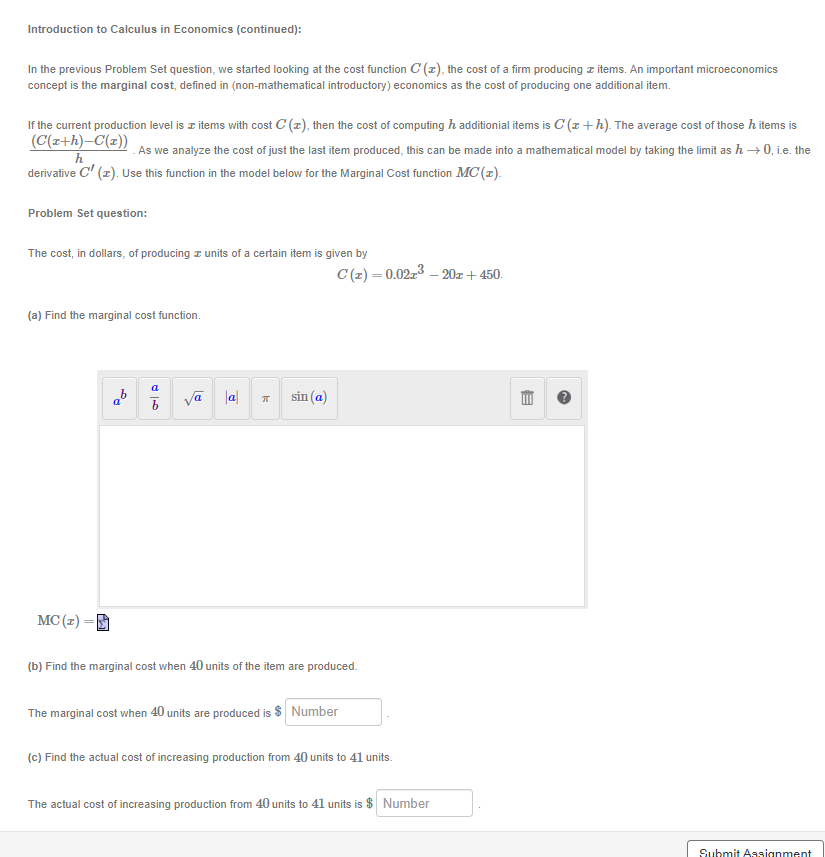Introduction to Calculus in Economics (continued): In the previous Problem Set question, we started looking at the cost function C(2), the cost of a firm producing items. An important microeconomics concept is the marginal cost, defined in (non-mathematical introductory) economics as the cost of producing one additional item. If the current production level is az items with cost C(z), then the cost of computing ħ additional items is C(z+h). The average cost of those hitems is (C(x+h)-C(x)) As we analyze the cost of just the last item produced, this can be made into a mathematical model by taking the limit as h→0, i.e. the h derivative C¹ (z). Use this function in the model below for the Marginal Cost function MC (2). Problem Set question: The cost, in dollars, of producing a units of a certain item is given by (a) Find the marginal cost function. MC (2) - ab b √a a k sin (a) C(z)=0.02³-20+450. (b) Find the marginal cost when 40 units of the item are produced. The marginal cost when 40 units are produced is $ Number (c) Find the actual cost of increasing production from 40 units to 41 units. The actual cost of increasing production from 40 units to 41 units is $ Number E
Introduction to Calculus in Economics (continued): In the previous Problem Set question, we started looking at the cost function C(2), the cost of a firm producing items. An important microeconomics concept is the marginal cost, defined in (non-mathematical introductory) economics as the cost of producing one additional item. If the current production level is az items with cost C(z), then the cost of computing ħ additional items is C(z+h). The average cost of those hitems is (C(x+h)-C(x)) As we analyze the cost of just the last item produced, this can be made into a mathematical model by taking the limit as h→0, i.e. the h derivative C¹ (z). Use this function in the model below for the Marginal Cost function MC (2). Problem Set question: The cost, in dollars, of producing a units of a certain item is given by (a) Find the marginal cost function. MC (2) - ab b √a a k sin (a) C(z)=0.02³-20+450. (b) Find the marginal cost when 40 units of the item are produced. The marginal cost when 40 units are produced is $ Number (c) Find the actual cost of increasing production from 40 units to 41 units. The actual cost of increasing production from 40 units to 41 units is $ Number E
Algebra & Trigonometry with Analytic Geometry
13th Edition
ISBN:9781133382119
Author:Swokowski
Publisher:Swokowski
Chapter7: Analytic Trigonometry
Section7.6: The Inverse Trigonometric Functions
Problem 91E
Related questions
Question

Transcribed Image Text:Introduction to Calculus in Economics (continued):
In the previous Problem Set question, we started looking at the cost function C(z), the cost of a firm producing items. An important microeconomics
concept is the marginal cost, defined in (non-mathematical introductory) economics as the cost of producing one additional item.
If the current production level is items with cost C(z), then the cost of computing ħ additional items is C (1+h). The average cost of those h items is
(C(x+h)-C(x))
As we analyze the cost of just the last item produced, this can be made into a mathematical model by taking the limit as h→0, i.e. the
h
derivative C² (2). Use this function in the model below for the Marginal Cost function MC(z).
Problem Set question:
The cost, in dollars, of producing units of a certain item is given by
(a) Find the marginal cost function.
MC (2)=
a
b
√ā a
k
sin (a)
C(z) = 0.02r³ - 20z + 450.
(b) Find the marginal cost when 40 units of the item are produced.
The marginal cost when 40 units are produced is $ Number
(c) Find the actual cost of increasing production from 40 units to 41 units.
The actual cost of increasing production from 40 units to 41 units is $ Number
E
Submit Assignment
Expert Solution
This question has been solved!
Explore an expertly crafted, step-by-step solution for a thorough understanding of key concepts.
This is a popular solution!
Trending now
This is a popular solution!
Step by step
Solved in 2 steps with 2 images

Follow-up Questions
Read through expert solutions to related follow-up questions below.
Follow-up Question
part a of this question was incorrect. Can you help explain please?
Solution
Recommended textbooks for you

Algebra & Trigonometry with Analytic Geometry
Algebra
ISBN:
9781133382119
Author:
Swokowski
Publisher:
Cengage

Algebra and Trigonometry (MindTap Course List)
Algebra
ISBN:
9781305071742
Author:
James Stewart, Lothar Redlin, Saleem Watson
Publisher:
Cengage Learning

Algebra & Trigonometry with Analytic Geometry
Algebra
ISBN:
9781133382119
Author:
Swokowski
Publisher:
Cengage

Algebra and Trigonometry (MindTap Course List)
Algebra
ISBN:
9781305071742
Author:
James Stewart, Lothar Redlin, Saleem Watson
Publisher:
Cengage Learning